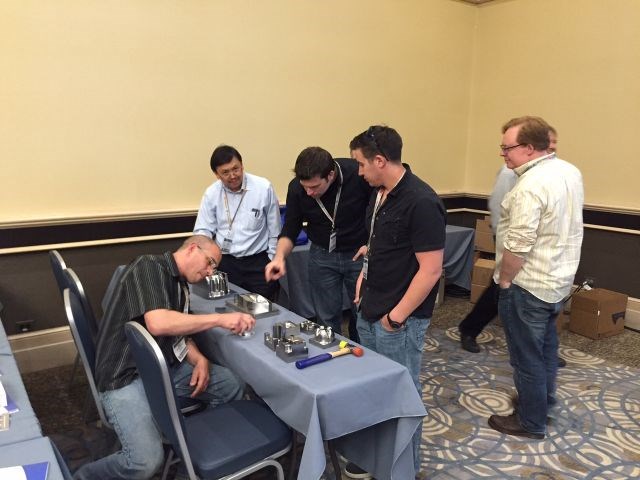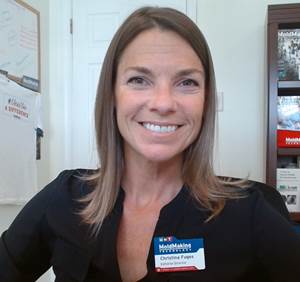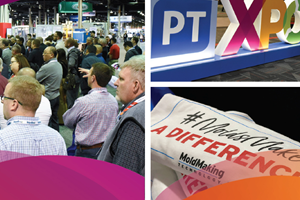A Look at What You Missed
What happens at Amerimold stays at Amerimold. Well, that’s not true. Attendees return to their shops with what they’ve learned from the technical conference program and exhibit floor technology displays. Here is a look at what you may have missed.
Along with conveying some intentional humor, several of the reasons on our annual Top 10 Reasons to Be a Moldmaker list point out the skill and craft necessary to excel in mold manufacturing; and the No. 1 reason emphasizes the attitude needed to persist in this career: “There is no crying in moldmaking!” Despite the demands of this profession, there continues to be a lot of excitement around the technologies and opportunities this industry presents, and this was evident at Amerimold 2015.
Amerimold has become a gathering place, where new industry contacts are made, existing relationships are revived, technologies are explored and strategies are shared—all of which help to improve moldmaking operations and to address the current challenges of the industry. This year’s event proved that the business climate is good—the molding and tooling industries are both in very good shape. For example, automotive is very strong, as is medical; packaging is fair and consumer products is solid. Quoting, for many, has been very heavy for the past four months. Many exhibitors and attendees pointed to the quantity of work currently out there, but also noted that it takes a long time to get approved data. Several predict a tidal wave of business to hit late this summer. So it would seem that Amerimold was perfectly timed to help arm moldmakers and molders with the products, equipment and processes they need for the current business level and that which is to come.
The innovation displayed on the show floor and discussed within the conference program was specifically geared toward engineering, building and maintaining a better mold—everything from software, additive manufacturing and training to mold materials, hot runners and mold components to machining and cutting tools to surface treatment, maintenance and repair, and much more.
Attendees were quick to share with me what they were looking for at Amerimold. One of the biggest challenge areas for shops is shopfloor management, as there does not seem to be a solid off-the-shelf software solution. Shops are looking for any progress on manufacturing resource planning (MRP), scheduling, program management and quoting software. For mold materials, there is an interest in performance alloys, pre-hards and aluminums. Moldmakers want to learn when and where to use them, as well as what coatings will help with wear and durability. In the mold component area, shops are on the hunt for easier components that they can purchase rather than manufacture themselves, including undercut release systems, modular slide and mold release systems, collapsing cores, sleeve and core pin systems, advanced hot runner options, and mold monitoring systems. When it comes to equipment, shops want to learn how best to leverage new machine technology such as simultaneous five-axis machining, multi-tasking machining and CNC grinding. Finally, moldmakers are also interested in learning more about conformal cooling and thermal-cycling injection molds (fast heat/cool), and find out when hybrid additive and subtractive machines will be relevant for everyday mold shop usage.
Checking in with exhibitors and presenters, many were promoting themselves as "solutions providers" as opposed to just sellers of products and services. For Missler Software, for example, the goal was simple. This company wanted attendees to understand that working with a true turnkey manufacturing solution was in their best interests. Through the use of live software presentations lasting about 20 minutes each, Missler showed visitors how working with a PDM-based CAD/CAM solution like TopSolid can really make a difference to their manufacturing experiences. The company noted that the best part of the show was that attendees were there looking for solutions, which is a great sign for the industry and the economy.
The goal of several mold material suppliers was to educate about material options. International Mold Steel showed attendees that there are much better mold steels on the market today than there were 50 years ago, and that by changing to a newer material, customers can lower overall tool costs, making them more competitive. Ellwood Specialty Steel took time to present on proper mold steel selection and its impact on part quality, process efficiency and minimal maintenance. Clinton Aluminum spoke once again about the use of aluminum tooling and how aluminum mold alloys and its applications continue to reach people that are just starting to consider its use an alternative to steel tooling. Clinton has worked with many of the other exhibiting companies at Amerimold, and these relationships help them provide answers for other questions regarding aluminum use in mold applications.
Beaumont Technologies presented on the science of runner design, which was very well attended with more than 60 molders, mold designers and mold builders who learned that in today’s injection molding industry, there is actually very little science applied to the design of runners in injection molds. Due to the extremely complex interaction of polymer and mold, the injection molding industry far too often relies on legacy design methods and old “industry art”.
According to Hasco, Amerimold provided an ideal opportunity for them to present the company under its new branding in the United States, as they start to serve the North American market more intensively with a newly configured team. One hot market segment is medical, and this was evident with increased attendee interest in its DLC-coated products that are suited to clean rooms, as well as its collapsible core technology.
At the Stratasys booth the more popular molding application for FDM technology was its thermal vacuum forming mold. This technology can manufacture parts with internal air gaps, creating hollow parts that allow them to pull a vacuum through for shaping thin pieces of plastic, mostly used in packaging.
OSG USA emphasized the importance of having the right mix of tooling, machine tools and programming. The company noted that many shops have adequate equipment, but there's always room for improvement in the techniques they use to get jobs done efficiently. OSG not only exhibited at the show, but held a four-hour workshop with SurKut Machine on a step-by-step process to guide your approach to programming 3D parts.
Makino demonstrated an a51nx horizontal machining center equipped with the FCS fixture system machining an aluminum bottle mold, illustrating how to use production methods for mold manufacturing. Makino sees a trend toward mold builders purchasing HMCs to take advantage of pallet change/fast setup capabilities, and the ability to use multiple setups to improve spindle and capital utilization. Incorporating a flexible, repeatable fixture method enhances the HMC as a process solution for molds and dies.
Bales Metal Surface Solutions attributes the fact that it is a 17-year Amerimold exhibitor and conference presenter to the event’s energy and highly engaged attendees. It participates in the show to be a technical resource for those who may be having molding issues. With that in mind, the company introduced a new product this year: Diamond EN is an electroless nickel coating with nano-sized diamond particles that are said to increase wear and friction resistance.
Mold Tech showed attendees how it can collaborate with a tool shop to eliminate slide-to-cavity seams in many tool designs. Parts were presented that showed typical (good-fit) seams from the cavity-to-slide fit, and then the same parts were shown after the zero parting line (ZPL) work was done. The seams were completely gone. Mold Tech also briefly described, but did not show, its proprietary ZPL process. Many attendees requested the presentation for their tooling teams and management.
Amerimold also brought to life MoldMaking Technology’s Pellet to Part (P2P) article series, produced with ROI Industries, through three specialized seminars. In the first, ROI Industries drove home the value of thinking in plastic, not just steel, with an overview of raw materials; screw, valve and end cap; hot/cold runner systems; hot runner controllers; mold cooling; plant water system performance; and automated part handling. In the second seminar, Krauss Maffei helped break down mold considerations when assessing robotics requirements with a look at how to make the decision between a linear or articulated robot, or a combination of both. In the third presentation, United Tool honed in on the importance of building molds with maintenance in mind from the beginning, which includes preventative maintenance planning and execution, designing the plan to minimize labor and fixed cost while maximizing ROI, capacity planning (labor hours and machinery), and moldmaker/molder upfront involvement when the PM plan and budget is set. The overall goal of this series of sessions was to reach moldmakers and molders to get them thinking about more than their specific skill set or discipline. They were asked to look both upstream and down to understand and add value as a supplier to the customer.
When all is said and done, this year's Amerimold covered a lot of ground in two days for its 2,700 registrants, and continues to provide the exhibitor and attendee great opportunities to have meaningful dialogue about every aspect of the tooling process. The highlights I mention here are only a glimpse of all the activity from the show floor, conference programming and networking opportunities. Check out our Amerimold Zone for more show information, and then mark your calendars for next year's event in Novi, Michigan!
Related Content
Moldmaking, the Relentless Pursuit of Innovation … Oh Yeah!
Innovation was at the root of the presentation lineup for the 2023 MoldMaking Conference, which included a heavy focus on automation, collaboration and communication, as well as mold design, talent development, reshoring and sustainability.
Read MoreWhere Mold Manufacturing and Plastics Processing Connect
The Moldmaking Pavilion is one of seven pavilions returning to the show that houses exhibitors offering technology and service solutions for your specific moldmaking needs.
Read MoreMoldMaking Technology's Leadtime Leader Awards Competition Returns!
After a brief hiatus, MoldMaking Technology’s Leadtime Leader Awards Competition is back!
Read MoreMore Than Moldmaking at PTXPO 2023
The Moldmaking Pavilion returns to the Plastics Technology Expo (PTXPO) March 28-30, 2023, at the Donald E. Stephens Convention Center in Rosemont, Illinois, but there’s more to discover than moldmaking.
Read MoreRead Next
Reasons to Use Fiber Lasers for Mold Cleaning
Fiber lasers offer a simplicity, speed, control and portability, minimizing mold cleaning risks.
Read MoreHow to Use Strategic Planning Tools, Data to Manage the Human Side of Business
Q&A with Marion Wells, MMT EAB member and founder of Human Asset Management.
Read MoreHow to Use Continuing Education to Remain Competitive in Moldmaking
Continued training helps moldmakers make tooling decisions and properly use the latest cutting tool to efficiently machine high-quality molds.
Read More

















_300x250 4.png;maxWidth=300;quality=90)
.jpg;maxWidth=300;quality=90)






_300x250 1.png;maxWidth=300;quality=90)







